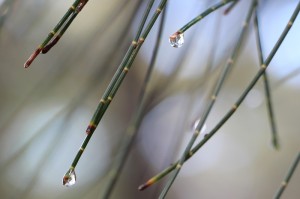Whispering Sheoak
 Wind moving through the Sheoak (Allocasuarina) makes a wonderful, whooshing, whispering sound. There have been quite strong southerly winds for the last few evenings while I have been collecting fodder for the goats after feeding the guinea fowl. The goats love Sheoak – and also enjoy Jarrah leaves – but will not touch the Spotted Gum. (Unfortunate, as we have to prune 1500 of them this year and it would have been nice to have been able to feed some to the goats.) The trees have been whispering to me while I cut off branches for the goats.
Wind moving through the Sheoak (Allocasuarina) makes a wonderful, whooshing, whispering sound. There have been quite strong southerly winds for the last few evenings while I have been collecting fodder for the goats after feeding the guinea fowl. The goats love Sheoak – and also enjoy Jarrah leaves – but will not touch the Spotted Gum. (Unfortunate, as we have to prune 1500 of them this year and it would have been nice to have been able to feed some to the goats.) The trees have been whispering to me while I cut off branches for the goats.
According to Wikipedia, sheoaks, like pines, have little cones full of seeds and attract many native birds. Sheoak foliage is not made up of leaves, but rather very fine ridged branches or ‘branchlets that look like long pine needles’. When a branchlet is pulled apart and looked at under a lens, you can see the tiny teeth-like points, which are the true leaves, at the end of each branchlet. The number of teeth will tell you which species the tree belongs to. These reduced leaves give casuarinas a great advantage in the harsh Australian climate. Water loss is minimised as the fallen branchlets form a thick blanket underneath the tree acting as a thick mulch which suppresses weeds and helps to stabilise soil from erosion. The Sheoak is important to Aborginal women who traditionally sat on the soft needles under the Sheoak while menstruating or giving birth. To add to its wide range of benefits, it also fixes nitrogen in the soil.
One of the sub-species has been recommended for windbreaks. Casuarina cunninghamiana (or River Oak) will grow to a height between 15 and 35 metres. It is often seen on river banks and in urban plantings and is often used as a windbreak.

Facebook